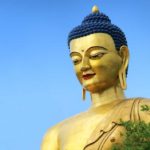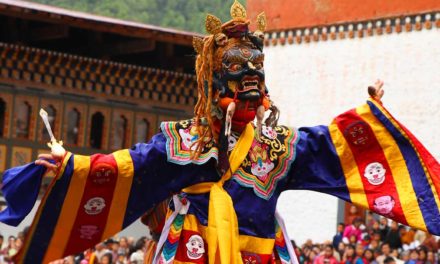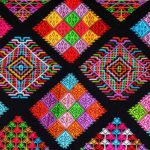
National Symbols
National Flag: The Bhutanese flag is divided diagonally into equal yellow and orange halves and exhibits a white dragon or a Druk across the middle. The upper part of the flag is golden yellow, representing the secular power of the king, while the lower part is orange, symbolising the Buddhist religion. The dragon, white in colour, is a symbol of purity, representing Bhutan. The jewels held in its claws epitomize the wealth and perfection of the country.
National Emblem: The national emblem is contained in a circle and is composed of a double diamond-thunderbolt or Vajra placed just above a lotus, surmounted by a jewel and framed by two dragons. The thunderbolt symbolizes the harmony existing between secular and religious power, which results from the Buddhist religion in its Vajrayana form. The lotus represents purity; while the jewel stands for sovereign power; and the two dragons, male and female, truly depict the name of the country, declaring it in their great voices to be the land of thunder and dragons.
National Flower: Blue poppy or Meconopsis grandis, which grows at high altitudes of the alpine meadows of Himalayas, is the national flower of Bhutan. Despite its pretty and delicate appearance the blue poppy has the power to endure harsh weather, especially winter, and blooms to its full beauty in spring.
National Tree: The national tree of Bhutan is the cypress (Cupressus torolusa), or as it is locally known Tseden. It is often associated with religious places. The Bhutanese identify with it, as it is straight and strong and can grow in inhospitable soil.
National Animal: The national animal is the Takin (Burdorcas taxicolor), an extremely rare bovid mammal of the ovine-caprine family. It lives in herds in the steepest and most thickly wooded declivities of native mountains at an altitude of 4,000 metres (over 13,125 feet), and eats bamboo. It can weigh as much as 250 kilograms (550 pounds). In summer, Takins form large herds (up to 300 at a time). They go into cover at midday and come out late in the afternoon. Locally they are known as Dong Gyem Tsey.
National Sport: The national sport of Bhutan is archery. Animated competitions, usually accompanied by a banquet, are a part of all festive occasions. Contests take place throughout the year. Since time immemorial, Bhutanese have been passionate about their national sport of dha (archery). Competitions are a riot of colour and excitement, usually accompanied by a banquet, and are a part of all festive occasions. In these contests the two teams in traditional dress shoot at small wooden targets placed 140m apart (Olympic standard is 50m).
National Bird: The national bird is the Raven (Corvus Corax Tibetanus). It is locally known as Jarogi, and it was once a capital crime in Bhutan to kill one. Ravens are even known to nest in the walls of the nation’s monasteries and dzongs. Bhutan’s reverence for birds is even exhibited on the Royal Raven Crown of the Druk Gyalpo.
The Raven in Bhutan history is the guardian Deity Mahakala, who is believed to have taken the form of a raven to guide Zhabdrung, who unified the country.
National Anthem: The National Anthem was first composed in 1953. It became official in 1966. The first stanza can be translated thus: In the kingdom of the dragon; the southern land of sandalwood; long live the king who directs the affairs of both the state and religion.
National Day: National Day is celebrated on the day that commemorates the ascension to the throne of Ugyen Wangchuck, the first king of Bhutan, at Punakha Dzong on 17 December 1907.




